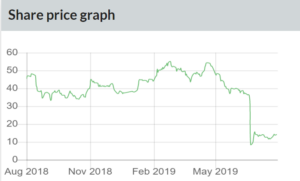Being a publicly traded company can be a blessing or a curse. Manchester, UK based quantum dot supplier Nanoco (LSE:NANO) has been feeling more cursed then blessed lately. Their stock price took a 74% hit in June when it was announced that a major US customer was backing out of a contract that had previously been highly promoted.

LSE:NANO takes a hit in June 2019.
In January 2019 Nanoco publicly stated that they had signed contract extension with the unnamed US company, even going so far as to call it “pretty secure revenue.”
CEO Michael Edlemen stated during an interview in April that “90% of revenue is coming from undisclosed US customer.”
These statements are now coming back to haunt them.
While Nanoco has refused to name the customer, many others have connected the dots and say Apple is the US customer in question. Publicly it has been reported that the discontinuation of the contract is not a fault of Nanoco material performance, but rather a strategy adjustment by the customer. Of course, we may never really know if this is the case or not.
As a scientist, I try to rely only on data to make decisions and projections, but I’ll put on my wildly speculative hat for a moment and make some educated guesses about what could have happened.
Assuming the masses are right, and the unnamed US company is Apple, there are a few different ways Apple (or a similar company) could be designed QDs into products. Frist is the obvious display application where the QDs are acting as R/G down-converters for blue LED-driven monitors and phones. Since mobile seems to be trending more towards OLED, I don’t think it’s likely that QDs were being slated for mobile display use. Monitors and laptops from Apple currently use GE’s KSF/PFS narrow-band red phosphor to achieve wide color gamut – QDs were perhaps being explored as an alternative but did not make the cut. There is another way some of these devices could benefit from QDs though, and we can’t even see it with our eyes.
Maybe some of you remember that in 2017 Apple acquired InVisage, a company focused on developing quantum dot sensors for cameras. Presumable the acquisition of InVisage was to bolster their position in next-gen technology where QDs would be used as an active component for infrared cameras vital for facial recognition. Nanoco could have been chosen to supply QDs for development of a product containing QDs for IR photodetectors. If the claim that the former Nanoco client has chosen a different strategy, this could mean that the acquisition of InVisage by Apple was a bust, and they may not be moving forward with QD cameras in our phones (which would be a bummer, I was hoping to write about that soon!).
Now, I’m a sucker for the infrared applications of QDs, so I may be biased in my speculation, but either way (display or infrared application) there are likely to be a number of other companies in the same boat as Nanoco – we just don’t hear about it because they are not public. Tech companies source from many different suppliers to qualify multiple material streams. In this case I suspect Nanoco was one of many companies that could have been impacted by the strategy change at “unnamed US company” (aka Apple).
Since the low point of £0.06 during the June crash, Nanoco stock has risen slightly to around £0.13, still nowhere near the 52-week high of £0.55 earlier this year.
To be clear, the events taking place at Nanoco are not uncommon, and anyone in the QD world will confirm the ups and downs this technology has seen. QDVision, Nanosys, and others have all seen the ups and – sometimes very deep – downs that QD companies must endure. It has admittedly taken longer than most thought for QDs to be widely adopted in TVs, but it seems to finally be happening given the price points we are seeing this year. The two leaders providing QDs materials (and IP) to the display industry (Samsung and Nanosys) tend to limit details of financials, contracts, and forecasts, but it seems these two companies are still on course and continuing to push the technology forward. I don’t see the news of Nanoco as a black eye on the industry, rather a twisted ankle for one company that now must endure the painful and publicly obvious limp.
Peter Palomaki is the owner and chief scientist at Palomaki Consulting, a firm specializing in helping companies solve big problems at the nanoscale. He utilizes his expertise in quantum dots and materials chemistry to solve challenging problems with clients large and small.

